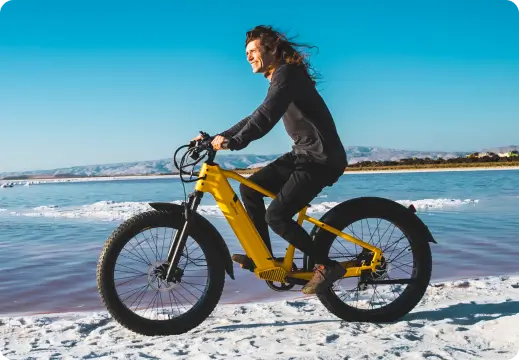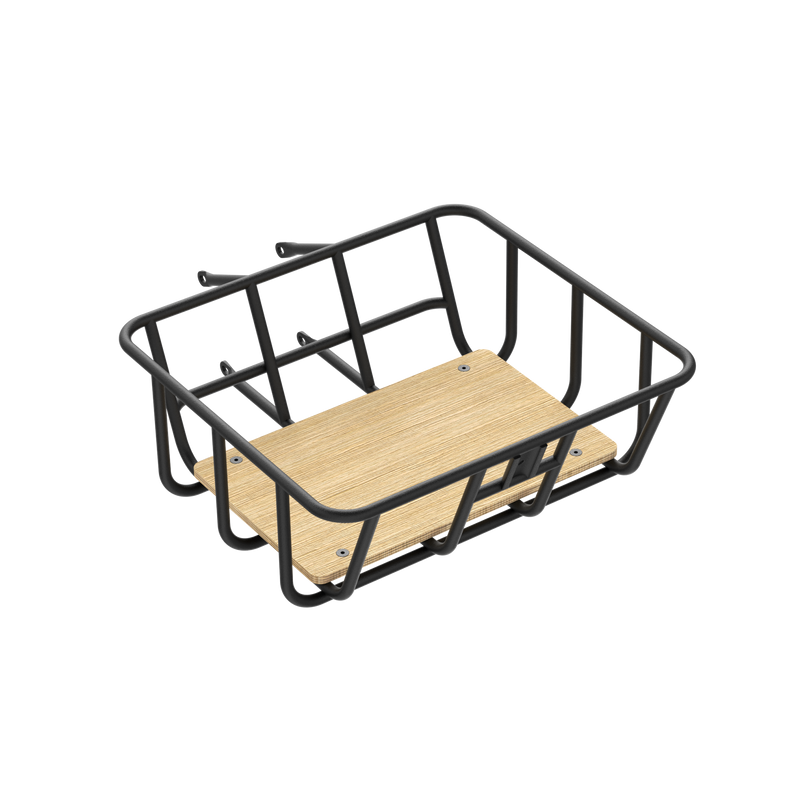Humans unknowingly collaborated to create one of humanity's most-used inventions.
Have you ever wondered where your favorite ride came from? Or about the centuries of development and engineering it took to bring you the bike sitting in your garage?
Today we’re explaining the full and extensive history of the bicycle. It took a long time to get from wooden wheels and no pedals to today’s fully motorized bicycles. From wooden frames to electric bikes, a lot has happened in the biking industry over the last two centuries.
Early 1800s: The First Bicycle
There is a surprisingly fierce debate regarding who actually invented the first bicycle.
In fact, there’s an organization — the International Cycling History Conference — that meets every year to discuss and debate the history of the bicycle. There’s quite a bit to discuss, like the time that the “evidence” that eonardo da Vinci invented the early bicycle was revealed as a hoax.
Who Invented the Bicycle?
While the facts around the bike’s invention are up for debate, most scholars and academics agree that the first recorded mention of a bicycle was in Germany in 1817. Baron Karl von Drais de Sauerbrun of Germany was the name in mention back then.
This bike was called the Laufmaschine, or the “Running Machine” in English. This steerable machine looked like a bike with no pedals and a large area in the middle for a person to stand or run inside it. Before “bicycles” was the go-to name, your ancestors might have tossed around words like “hobby horse, “dandy horse,” or “draisine” as well. These were also called boneshakers, as bikes back then provided a bit more of a bumpy ride.
The Laufmaschine might have been an impractical invention, but it got us on the right track toward the modern bicycle glory would use centuries later.
The Mid-1800s: New and Improved
The Laufmaschine picked up some steam recently after it was invented, but production was halted shortly thereafter because of the cost and impracticality. Wealthy Germans were also made fun of for riding these early bikes, which affected their popularity.
Let’s jump to 1840s Scotland, where the recipient of the “Most Scottish Sounding-Name Award,” Kirkpatrick Macmillan, started to tweak the Laufmaschine design.
Macmillan and a few others with equally-sounding Scottish names developed similar bicycle designs except with their own version of ‘pedals.’ Treadles were located by the rider's feet, which would connect to rods that turned the massive wooden wheels slowly but surely.
While Macmillan’s and other similar designs never hit the open market, they were the first evidence of a bike with something closely resembling pedals.
Vélocipède
Now, we flash forward to Paris in the 1860s. People across France had been calling bikes “vélocipède de pédale” until someone had the bright idea to call them bicycles in 1868.
Before that, the first instance of a bike with real pedals attached to the front was recorded in Paris around 1863, courtesy of Frenchman Pierre Lallement.
Besides the first use of the word bicycle, two other very important things happened in 1868: the world’s first bike race happened in Paris, and Lallement sold his bicycle patent to American entrepreneur Calvin Witty.
This is significant in the history of the bicycle because it eventually started an American obsession.
The Late 1800s: The American Craze and the Safety Bicycle
Naturally, once Americans got word of the vélocipède craze in Paris, it created close to a decade-long obsession: This was dubbed “vélocipèdomania.”
This craze primarily took place in New York City amongst the wealthier residents and quickly fizzled out by the mid-1870s due to production costs and impracticality yet again. While this machine was the closest to the bike as we know it today, the 19th-century contraption still wasn’t practical enough for long-distance travel, eventually leading to the craze dying out.
Fortunately, the Brits picked up on the development of the bicycle only a few years after vélocipèdomania. In England, James Starley’s newest invention in the 1870s, called the Ordinary, was the first real bike model. It was all metal — the bicycle frame and the wheels.
Starley’s first invention looked a little odd because the front wheel were so much larger than the back, yet the bicycle craze began once again both in Europe and America. The large front wheel led to the name “high wheeler” or “penny farthing.” The addition of spokes and pedals made for a more comfortable ride.
The big wheel was difficult to control, and getting on and off required a Master’s degree from Oxford. On a serious note, the cyclist’s center of gravity was off, and many joyriders found themselves flipping over the handlebars. It’s a shame 360-degree bike helmets hadn’t existed yet around at that time.
Safety Bicycles
The Brits attempted a quick fix to the safety problem, thanks to John Kemp Starley (nephew of James Starley). In 1885, John Kemp Starley invented the Rover Safety Bicycle, which resembled modern-day tricycles. The front and rear wheels were finally the same size! He also brought the chain drive to this model.
Safety bicycles started to overtake the Ordinary model very quickly. As a result, modern-looking bikes started to become common across Europe and the United States.
John Boyd Dunlop invented the inflatable rubber tire (pneumatic tires) in 1888, which made biking far more comfy. Here, we finally say farewell to metal tires. This was a considerable improvement, especially since the early 1800s model was called a boneshaker — and for a good reason.
Early 1900s: A Real Bicycle
By now, bikes are looking more and more like the ones we’re accustomed to in our present every day.
Previously, riders had to remove the wheel to switch between the two gears available on either side of the hub. By the ‘90s, gear shifts (the derailleur) had been added so that the gears could switch without removing the wheel. At this point, safety also wasn’t as much of a worry as it was with the Ordinary.
In 1899, the United States produced over one million bicycles. The real bicycle boom began. For about 20 years, bicycles were everywhere and used by everyone. Across Europe and the United States, mass production capabilities born from the Industrial Revolution led the bicycle to become not only a hobby but a lifestyle, especially in France.
Jump two decades later to 1920, and bikes were somewhat relegated to those who couldn’t afford automobiles. Nobody wanted a bike.
1960s: The Newest Fad
From the 1920s until around the 60s, biking in America had hit its all-time low: Bikes were still typically only used by the poor or teenagers and children. It wasn’t until a new high-rise bike design briefly took America by storm in the late 60s.
This bike was designed and meant for kids and teenagers — the only real biking demographic left at this point. By 1968, this bike accounted for over 75% of bike sales in the United States.
This craze died out very quickly as consumers outgrew their bikes past a certain age.
There was a brief two-year boom in 1972 for 10-speed bikes, which are models that had a two-gear system on the front wheel and a five-gear system on the back, providing 10 total speeds to choose from.
Then, the magic happened.
1970s and ‘80s: The Resurgence
This came in the form of one of the most important developments in the history of biking: the mountain bike.
The mountain bike was invented in California in the late 70s, and it didn’t take long for it to take hold of the biking world. 10-speed bikes were a thing of the past by the 80s and by 1993, mountain bikes accounted for 95% of all bike sales in America.
This was major for a few reasons: first, it recaptured the American imagination when it came to biking. Instead of simply a mode of transportation, you could now use your bike for real exercise and take it off-road.
Second, it showed that there was still plenty left to tweak and work with when it came to the bicycle. For 40 years, bikes largely remained the same. It wasn’t until this boom that other variations of bikes started to pop up, such as exercise bikes, racing bikes, and electric bikes.
The Early 2000s: E-Bikes and the Bikes We Know and Love
The journey through the history of the bike comes to an end with the invention and popularization of the electric bike.
Interestingly, the first “electric” bike popped up in the late 1800s when someone tried to attach a motor to a bike model. It didn’t catch on or work, so the idea largely died out until the 1990s.
Electric bikes didn’t become commercially successful until 1997, and hundreds of other models started to appear shortly after. From the 2000s to today, bikes began to take on the modern look we’re familiar with. They are especially helpful today in reducing carbon emissions, which is one of the biggest selling points for electric bikes.
From the Beginning to Today: Every Bike
Now that you’re all caught up on the complete history of the bicycle, let’s take you through brief descriptions of all the bikes we’ve covered.
Let’s take a brief walk (ride) through history, as humans now have an excellent tool for combating climate change and carbon emissions.
Laufmaschine (Draisine)
The “first” bike didn’t last more than five years.
It was impractical and silly-looking. Still, it was important in the conception and development of the bicycle.
Vélocipède
Our second bike development — this model would’ve made you thecenter of attention if you lived in Paris in the 1860s.
These were the first bikes with something close to a pedal, an important development.
Safety Bicycle
This is what we call a tricycle—the bike we let our toddlers use that was previously used by nobility. The tricycle is still used today and was instrumental in helping the overall design and shape of the modern bike.
Standardized Bicycle
We arrived at bike models as we know them today in the 1900s and never looked back. These are the bikes you think of when you hear the word, and it jump-started a multi-billion dollar industry.
Mountain Bikes
Mountain bikes trace back to the 1890s, with mountain bike races starting in the 1970s. When looking for mountain bikes, shoppers prioritize suspension and wheel diameter.
Electric Bikes
An electric bike is a bicycle with an electric motor that can help you pedal. E-bikes also give riders the option to run the bike manually with full leg power. The pedal assist system (PAS) provides support while you’re pedaling, while the throttle assist system moves the bike forward even when you aren’t pedaling.
Velotric’s e-bikes are equipped with both a PAS and a throttle system, so you can choose to pedal your bike manually, pedal your bike with assistance from the PAS, or refrain from pedaling altogether.
Different types of e-bikes are geared for certain activities. For instance, an urban bike like the Velotric T1ST is first-rate for commuting, reaching speeds of 20 or 25 miles per hour.
The importance of electric bikes cannot be understated, and we only expect the industry to continue to grow and flourish in the coming years. The Nomad 1 can go up to 25 miles per hour and, with its fat tires, is great for whatever your weekend has planned.
Velotric
Velotric is the premier producer and distributor of affordable electric bikes for all. Our e-bike models are safe and sleek, bringing joy back to your rides.
Come ride with us, and you’ll see why thousands of others say the same: We’re the best in the business. Get out there and start exploring; we’ll see you in the great outdoors!
Sources:
History of Bicycles | History Cooperative
Pierre Lallement and the Modern-Day Pedal Bicycle | ConnecticutHistory.org
The Bicycle’s Bumpy History | History
This Wooden Running Machine Was Your Fixie’s Great-Great Grandpa | Smithsonian Magazine
Who Actually Invented the Bicycle? It’s Been Debated for Centuries | Yahoo
1890’s The Ordinary High-Wheeler or Penny-Farthing | Historical Society of Martin County







































